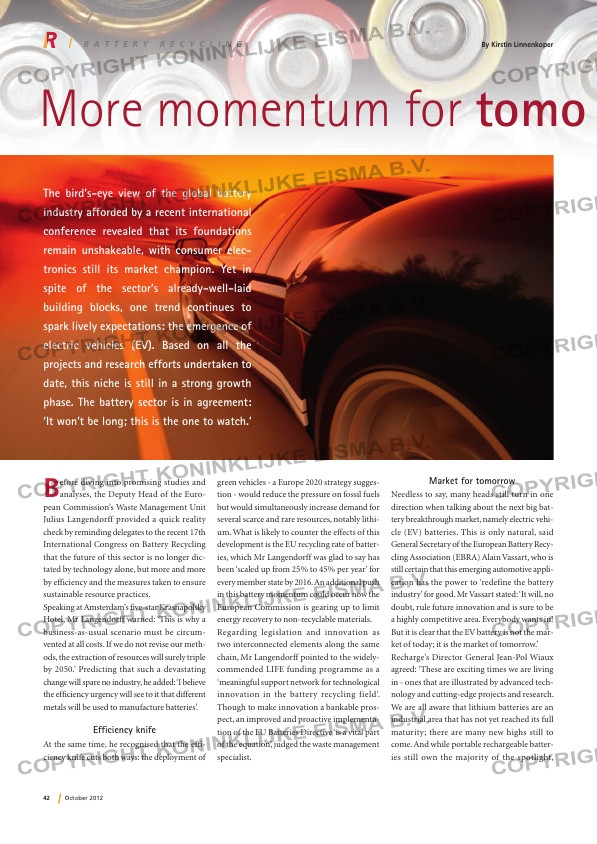Page 42 from: October 2012

42 October 2012
More momentum for tomo rrow’s batteries market?
Before diving into promising studies and analyses, the Deputy Head of the Euro-
pean Commission’s Waste Management Unit
Julius Langendorff provided a quick reality
check by reminding delegates to the recent 17th
International Congress on Battery Recycling
that the future of this sector is no longer dic-
tated by technology alone, but more and more
by efficiency and the measures taken to ensure
sustainable resource practices.
Speaking at Amsterdam’s five-star Krasnapolsky
Hotel, Mr Langendorff warned: ‘This is why a
business-as-usual scenario must be circum-
vented at all costs. If we do not revise our meth-
ods, the extraction of resources will surely triple
by 2050.’ Predicting that such a devastating
change will spare no industry, he added: ‘I believe
the efficiency urgency will see to it that different
metals will be used to manufacture batteries’.
Efficiency knife
At the same time, he recognised that the effi-
ciency knife cuts both ways: the deployment of
green vehicles – a Europe 2020 strategy sugges-
tion – would reduce the pressure on fossil fuels
but would simultaneously increase demand for
several scarce and rare resources, notably lithi-
um. What is likely to counter the effects of this
development is the EU recycling rate of batter-
ies, which Mr Langendorff was glad to say has
been ‘scaled up from 25% to 45% per year’ for
every member state by 2016. An additional push
in this battery momentum could occur now the
European Commission is gearing up to limit
energy recovery to non-recyclable materials.
Regarding legislation and innovation as
two interconnected elements along the same
chain, Mr Langendorff pointed to the widely-
commended LIFE funding programme as a
‘meaningful support network for technological
innovation in the battery recycling field’.
Though to make innovation a bankable pros-
pect, an improved and proactive implementa-
tion of the EU Batteries Directive ‘is a vital part
of the equation’, judged the waste management
specialist.
Market for tomorrow
Needless to say, many heads still turn in one
direction when talking about the next big bat-
tery breakthrough market, namely electric vehi-
cle (EV) batteries. This is only natural, said
General Secretary of the European Battery Recy-
cling Association (EBRA) Alain Vassart, who is
still certain that this emerging automotive appli-
cation has the power to ‘redefine the battery
industry’ for good. Mr Vassart stated: ‘It will, no
doubt, rule future innovation and is sure to be
a highly competitive area. Everybody wants in!
But it is clear that the EV battery is not the mar-
ket of today; it is the market of tomorrow.’
Recharge’s Director General Jean-Pol Wiaux
agreed: ‘These are exciting times we are living
in – ones that are illustrated by advanced tech-
nology and cutting-edge projects and research.
We are all aware that lithium batteries are an
industrial area that has not yet reached its full
maturity; there are many new highs still to
come. And while portable rechargeable batter-
ies still own the majority of the spotlight,
B A T T E R Y R E C Y C L I N G By Kirstin Linnenkoper
The bird’s-eye view of the global battery
industry afforded by a recent international
conference revealed that its foundations
remain unshakeable, with consumer elec-
tronics still its market champion. Yet in
spite of the sector’s already-well-laid
building blocks, one trend continues to
spark lively expectations: the emergence of
electric vehicles (EV). Based on all the
projects and research efforts undertaken to
date, this niche is still in a strong growth
phase. The battery sector is in agreement:
‘It won’t be long; this is the one to watch.’
R _8- in .indd 2 08-10-12 1 :21



